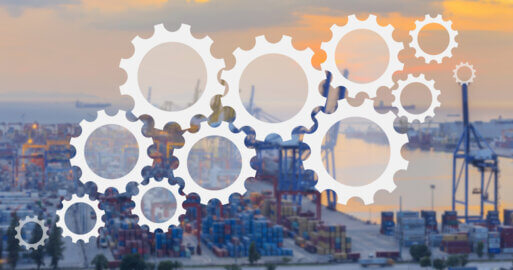Transparent, Efficient Supply Chains Are the Future of Retail

If you want long-term success in today’s retail industry, a transparent, efficient supply chain is crucial. To meet these increasing demands for visibility and harmonized processes, retailers also need to optimize their supplier management. What are the benefits – and obstacles – that retailers experience in optimizing their supply chains? This blog discusses the importance of a transparent, efficient supply chain for retailers and the important role played by data integration.
No efficiency without visibility
A fine-tuned supply chain is essential if you want to be successful in today’s dynamic retail sector. However, before you get started, you will need to ensure that you have a data environment that is fit for purpose and that you have eliminated pesky data silos. Ideally, all the systems used within the supply chain, including supplier management systems and e-commerce platforms, should be seamlessly connected with one another. This lets you draw all information on product availability, product status and shipment condition in real time from isolated sources, and merge this in a central place, a single source of truth.
Supply chain efficiency in the retail sector
Transparency is the cornerstone of an efficient supply chain, as its builds the foundation for future optimization opportunities. Let’s look at six benefits of transparent supply chains:
- Supply chain visibility gives you the information and insights you need to identify bottlenecks and inefficient processes, as well as to optimize your inventory management.
- A transparent supply chain lets companies track the exact location and status of their products throughout the supply process, which also simplifies product recalls.
- Visibility in your supply chain builds trust with your customers, suppliers and partners. Customers appreciate being kept up to date on the status of their orders. In turn, business partners see that bottlenecks can be resolved more easily with the help of a modernized data environment. This improves business processes, which ultimately enhances the customer experience.
- Access to real-time analytics lets you more accurately forecast demand and deploy personnel and logistics services more efficiently.
- Performing analytics on the ready stream of supply chain data makes it easier for retailers to provide their customers with the right products at the right time. This not only reduces stock levels, it also increases customer satisfaction.
- A state-of-the-art data environment helps to increase the security of goods and deliveries. Accurate tracking of items all along the supply chain – right to the customer – can reduce shipping losses.
- Ultimately, visibility along the supply chain enables retailers to optimize operations, reduce costs and increase customer satisfaction. It creates the basis for data-driven decisions that lead to a more efficient supply chain while ensuring the quality and security of the products.
What are the obstacles in optimizing a supply chain?
Despite the obvious benefits of supply chain visibility, achieving full transparency is becoming increasingly difficult. This is because there are a number of challenges confronted by retailers wanting to optimize their supply chain. These boil down to three main issues.
- Fragmented business processes and data. Often, business processes and data are isolated in different systems or departments. This makes seamless communication and collaboration along the supply chain difficult.
- Inadequate technical infrastructure and/or digitalization. Some retailers do not have the necessary technology for efficient data processing, analysis and integration. This affects real-time visibility and can lead to inaccurate forecasting and difficulties in adapting to shortages or product recalls.
- The complexity of global supply chains. In a globalized world, retailers often source products from different countries and regions. The complexity of these global supply chains can make monitoring and management difficult.
Data integration is the key to an efficient, transparent supply chain
What is data integration and how does it work?
In a complex retail operation, there will be numerous processes running in parallel, from placing and processing an order, to warehouse management and logistics. These processes generate a wealth of data, often in different systems and formats. Data integration involves centrally collating and giving this wealth of information a common basis so it can seamlessly flow between the disparate systems that need it.
Data integration requires a reliable and powerful integration solution that enables data to be exchanged between a company’s internal systems, external partners, suppliers and customers. This transmits both structured and unstructured data, either in real time using APIs or in batch mode using EDI. Data integration gives you a 360-degree view of the supply chain, letting you better coordinate processes and identify bottlenecks at an early stage.
The role of data integration in the supply chain
Data integration plays a crucial role in increasing efficiency and transparency in the supply chain. It connects all parties and ensures a smooth information exchange between these. This naturally makes the supply chain more agile and dynamic, particularly concerning the following advantages:
- Real-time information. Data integration enables retailers to receive real-time information on an order status, stock levels and deliveries. This lets them react quickly to changes and proactively mitigate bottlenecks and delays.
- Automated processes. A well-integrated supply chain lets you automate a number of previously manual workflows. This not only reduces the time needed, it also removes the risk of human error.
- Improved cooperation and collaboration. Data integration promotes seamless communication between retailers, suppliers and logistics providers. Information can be securely shared and made visible between parties, facilitating coordination and planning.
- Traceability and compliance. Thanks to data integration, retailers can accurately track the origin of their products and ensure that they comply with applicable regulations and quality standards.
SEEBURGER data integration capabilities for retail
The SEEBURGER Business Integration Suite (BIS) contains a number of integration solutions that retailers use to increase their supply chain efficiency and create greater visibility in their supply chain. Retailers benefit from a number of the capabilities and prepackaged processes on the SEEBURGER BIS platform, including the following:
- The B2B/EDI capabilities on the SEEBURGER BIS enable electronic data interchange with suppliers, forwarders and other trading partners. Communicate seamlessly with your business partners and exchange data securely using the BIS B2B/EDI capabilities. They speed up order processing while reducing your workload.
- B2B/EDI Cloud Integration Services: The cloud-based B2B onboarding service lets you quickly and easily connect your partners to your EDI system. Benefit from faster onboarding, better data maintenance, increased efficiency and scalability, lower costs, better responsiveness and central compliance management for customers and partners with the SEEBURGER Community Management Application (CMA).
- The API management capabilities on the SEEBURGER BIS let companies make their systems and data securely available to external partners, facilitating collaboration and cooperation.
The SEEBURGER solutions for digitalization in retail enable visibility in the supply chain, a personalized shopping experience, faster response times and, quite simply, happy customers all round.
Whitepaper
Harmonize your connections for seamless data flow. Our white paper Five Reasons Why You Need Harmonized Retail Connections looks at how to deploy the SEEBURGER BIS platform to future-proof your IT architecture.
DownloadThank you for your message
We appreciate your interest in SEEBURGER
Get in contact with us:
Please enter details about your project in the message section so we can direct your inquiry to the right consultant.
Written by: Stefanie Albiez, Michael Kleinpoppen
Michael Kleinpoppen has over twenty years of digitalization experience and has been a key account manager at SEEBURGER AG since 2008. He supports German CPG retail clients, focusing on non-food, fashion and online retailers. His role involves working closely with customers and stakeholders to enrich and optimise their business models and sales strategies with digital solutions. This entails analyzing current digitalization practices at a company and advising and supporting customers to get the best out of their business through systems integration. Steffi Albiez joined SEEBURGER in 2021 after graduating in in business psychology. She uses her expert skills in marketing process automation and website optimization to support our CPG/retail, manufacturing engineering and pharmaceutical industry specialists. If you don't find Steffi engrossed in website code or research, you should look for her outside, where she's likely to be on the fields with her dog and horse.





